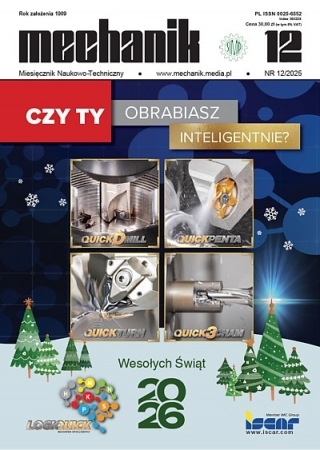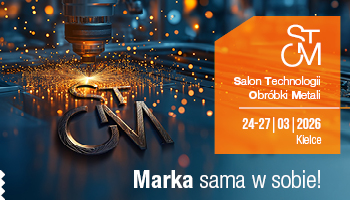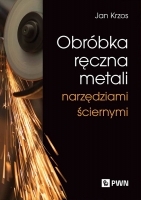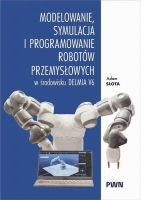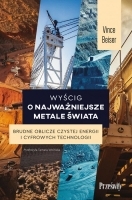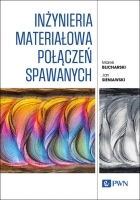Compressive properties of cell structures manufactured by photo-curing technology liquid polymer resins – Polyjet Matrix
Wytrzymałość na ściskanie struktur komórkowych wytwarzanych techniką fotoutwardzania ciekłymi żywicami polimerowymi – Polyjet Matrix *
Mechanik nr 01/2022 - Druk 3D
ABSTRACT: The article presents the results of compressive strength tests of cylindrical samples with a hexagonal cell structure. The samples were made of MED 610 material using the photo-curing technology liquid polymer resins. The compressive strength was estimated on the basis of a static compression test of the printed elements. It has been shown that the PolyJet Matrix 3D printing technology enables the printing models with a thin-walled cell structure, which, while maintaining the appropriate strength properties, can be used in the design and production of certain utility models.
KEYWORDS: 3D printing, PolyJet Matrix, compressive properties, cell structures
STRESZCZENIE: Przedstawiono wyniki badań wytrzymałości na ściskanie próbek cylindrycznych o heksagonalnej strukturze komórkowej. Próbki wykonano z materiału MED 610 z zastosowaniem techniki fotoutwardzania ciekłych żywic polimerowych. Wytrzymałość na ściskanie oszacowano na podstawie statycznego testu ściskania elementów drukowanych. Wykazano, że technologia druku PolyJet Matrix 3D umożliwia drukowanie modeli o cienkościennej strukturze komórkowej, co – pod warunkiem zachowania odpowiednich właściwości wytrzymałościowych – może być wykorzystane przy projektowaniu i produkcji niektórych wzorów użytkowych.
SŁOWA KLUCZOWE: druk 3D, PolyJet Matrix, właściwości ściskające, struktury komórkowe
BIBLIOGRAFIA / BIBLIOGRAPHY:
[1] Hong H., Hu M., Dai L. “Dynamic mechanical behavior of hierarchical resin honeycomb by 3D printing”. Polymers (Basel). (2021), https://doi.org/10.3390/polym13010019.
[2] Zeng C., Liu L., Bian W., Leng J., Liu Y. “Compression behavior and energy absorption of 3D printed continuous fiber reinforced composite honeycomb structures with shape memory effects”. Addit. Manuf. (2021), https://doi.org/10.1016/j.addma.2021.101842.
[3] Kozior T. “Rheological properties of polyamide pa 2200 in sls technology”. Teh. Vjesn. 27 (2020): 1092–1100, https://doi.org/10.17559/TV-20190225122204.
[4] Kozior T., Kundera C. “Viscoelastic properties of cell structures manufactured using a photo-curable additive technology – PJM”. Polymers (Basel). 13 (2021), https://doi.org/10.3390/POLYM13111895.
[5] Bochnia J., Błasiak S. “Anisotrophy of mechanical properties of a material which is shaped incrementally using PolyJet technology” in: Zolotarev I., Radolf V. eds., “Engineering Mechanics”. Kielce (2016).
[6] Álvarez-Trejo A., Cuan-Urquizo E., Roman-Flores A., Trapaga-Martinez L.G., Alvarado-Orozco J.M. “Bézier-based metamaterials: Synthesis, mechanics and additive manufacturing”. Mater. Des. (2021), https://doi.org/10.1016/j.matdes.2020.109412.
[7] EN ISO 10993-18:2009 Biological evaluation of medical devices – Part 18: Chemical characterization of materials (2009).
[8] EN ISO 10993-3:2014 Biological evaluation of medical devices – Part 3: Tests for genotoxicity, carcinogenicity and reproductive toxicit (2014).
[9] EN ISO 10993-10:2013 Biological evaluation of medical devices – Part 10: Tests for irritation and skin sensitization (2013).
[10] EN ISO 10993-5:2009 Biological evaluation of medical devices – Part 5: Tests for in vitro cytotoxicity (2009).
[11] “Stratasys MSDS Clear Bio-Compatible MED610”. Available online: https://www.sys-uk.com/wp-content/uploads/2016/01/MSDS-Clear-Bio-Compatible-MED610-English-US-1.pdf.
[12] “Stratasys Biocompatible Clear MED610”. Available online: https://cadxpert.pl/wp-content/uploads/2019/03/spec_PolyJet_MED610_MED620.pdf.
[13] Adamczak S., Bochnia J., Kundera C. “Stress and strain measurements in static tensile tests”. Metrol. Meas. Syst. 19 (2012): 531–540, https://doi.org/10.2478/v10178-012-0046-3. Unauthenticated.
DOI: https://doi.org/10.17814/mechanik.2022.1.1
* Artykuł recenzowany





